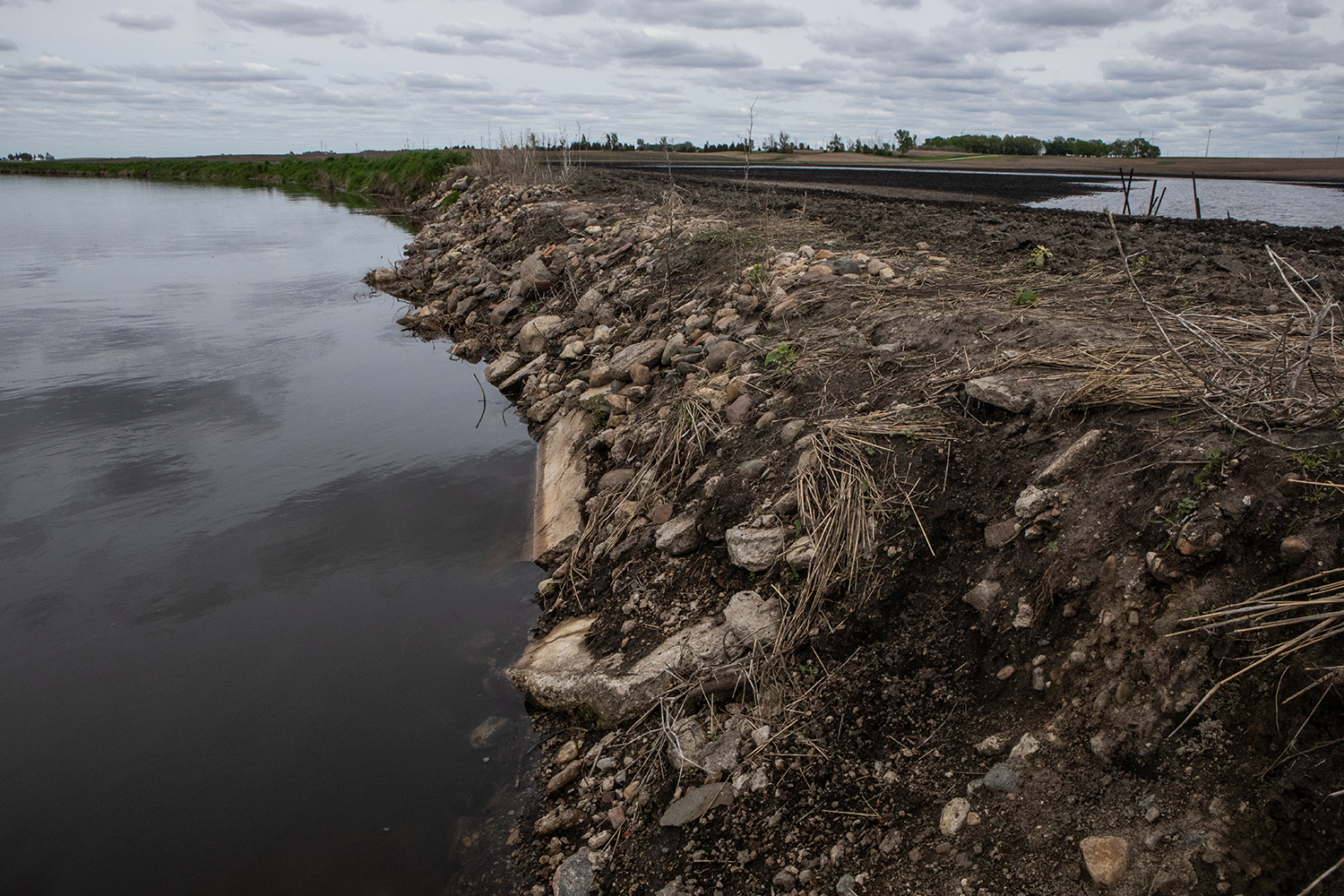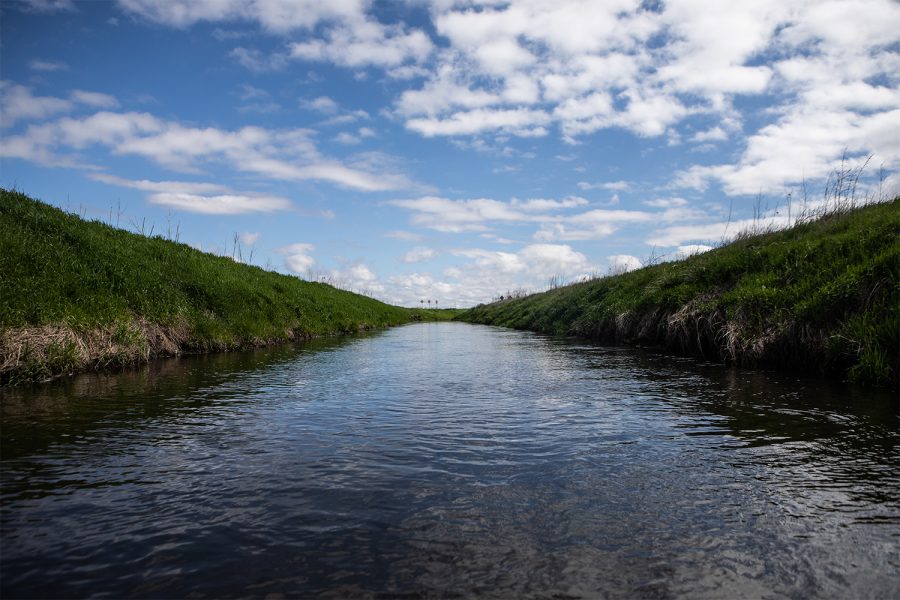Troubled waters: A DI journalist’s expedition on the Iowa River
Daily Iowan photojournalist Ryan Adams kayaked the 329-mile Iowa River and saw firsthand the effects of rising nitrate levels.
July 16, 2019
* Editors’ note: The nitrate levels in the below article do not fully reflect the actual nitrate levels in the Iowa river at the time. Test strips utilized for testing were intended for laboratory setting, not for use in the field.
For real-time data on nitrate levels in the Iowa River, you can view this link produced by Iowa IIHR.
I held tightly to the rope draped across my shoulder. On the other end of the rope was nearly 100 pounds worth of gear strapped to my kayak, meant to aid me in my 20-day trip from the Northernmost tip of the Iowa River in Crystal Lake to the Southernmost in Oakville. I had already traveled 11 days, and was exhausted from a day’s worth of paddling. It was 6 p.m. and I was tired and hungry. Dinner would consist of tea and mashed potatoes cooked on my Jetboil.
But dinner was a small concern compared to what was really driving me to make this expedition. The fact that as an Iowan, the issue of water quality has become increasingly politicized, while Iowa remains the leading contributor to nitrate pollution to the Gulf of Mexico. Iowa’s farm runoff is directly responsible for 45 percent of the hypoxic zone in the gulf.
I embarked on an expedition of the 329-mile Iowa River on May 20 to research nitrate levels — an indicator of water quality — in the waterway. I started my journey in the small stream that is the beginning of the Iowa River, near Crystal Lake, Iowa. Throughout the next month, I would paddle, photograph, test, and live on the water.
After conducting 104 nitrate tests * of the Iowa river and adjoining tributaries, I found the nitrate levels exceeded recommended limits, sometimes going 10 times over the suggested limit. These high levels could be attributed to the flooding that started in March and occurred throughout May and June, because stormwater can carry a large amount of nitrogen and phosphorus pollutants, according to the EPA.
Late in the afternoon during a particularly warm day, over 150 miles into my trip, I pulled my 14-foot kayak through the waterlogged timber that was supposed to be my campsite for the evening. Every step was met with difficulty as my sandals sunk into the muddy ground under the two feet of floodwater filling the forest.
Around me were maple and ash trees, their leaves shielding much of the wilderness management area north of Chelsea, Iowa, from my sight. The bottom of each tree emerged from the murky water, where other low-lying vegetation, of which I hoped was not poison ivy, covered the forest floor.
As daylight ran out, everything around me was submerged while I looked for a safe place to set up camp for the night. I heard owls hooting, the quiet hum of crickets chirping in the meadow, and deer moving through the tall grass around me. I began to navigate back onto the river once again, in hopes that I would find a piece of dry land to sleep for the night — otherwise, I might end up on the flooded water in the dark.
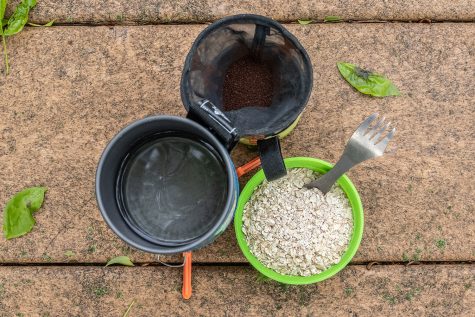
Daily Iowan Photojournalist Ryan Adams’s breakfast awaits preparation north of Alden, Iowa on the morning of May 25, 2019. Adams’s breakfast for each day of the expedition consisted of 3 packets of instant oatmeal and a cup of coffee.
These nights did not discourage me from collecting data along the river. I found nitrate levels to be between 25-100 mg/L on most parts of the river.* To put these findings into perspective, the EPA recommends 10mg/L as a cap for human consumption of water. Anything above might prove harmful to humans, as it affects the blood’s ability to carry oxygen.
The Environmental Working Group reports that even though the EPA recommends 10 mg as a nitrate limit, in order for there to be no adverse health effects, 0.14 mg is considered a safer amount.
Like most nights on the river, I sat in my two-person backpacking tent, looking through content I collected from the day. The shelter I managed to find was two miles downstream from where I had failed to find shelter before. Dusk had come, and a fog covered the field 100 feet from the riverbank. The setting sun left an orange-purple glow that illuminated the landscape.
This is what I was hoping for when I set out on my trip. The only way I saw fit to tell this story was by getting my hands dirty and my paddles wet. Exploration and curiosity were values I obtained from a childhood playing in the dense timber and stream that bordered our home.
They are also what motivated me to undertake this journey. If I wanted to understand the current condition of Iowa’s waterways, I had to see it, feel it, smell it, hear it, and taste it — though after seeing the water, I decided it might be safe to hold off on the taste test.
***
Iowa’s land fuels its agriculture industry. Approximately 3.2 million humans live in the state’s borders, but the 23 million hogs, 4 million cattle, and 60 million chickens involved in Iowa’s livestock industry outweigh the human population 27 times over, according to the Iowa Agriculture Literacy Foundation.
Livestock creates nutrient-rich manure, which aids in the growing of crops. Iowa produces more than 3 billion bushels annually between corn and soybeans alone. However, with such massive amounts of waste produced by the livestock population, some of the nutrients, like phosphorus and nitrogen, find their way into tilling systems and into our waterways.
Because of recent record rainfall in Iowa, a high concentration of farm runoff has found its way into major channels such as the Cedar and Iowa Rivers, where they eventually flow into the Missouri or Mississippi Rivers. These rivers eventually feed into the Gulf of Mexico.
Once in the Gulf, the nitrates that once promoted healthy crops then deplete oxygen levels in water, creating a “dead zone.” Filled with the nutrients from other states, the zone is uninhabitable to aquatic life, and this year it is predicted to cover an area the size of Massachusetts, according to the National Oceanic and Atmospheric Administration.
The idea was that I would use my boat to travel down the Iowa River while collecting water-quality tests of nitrate *, snapping pictures, shooting video, and interviewing Iowans along the way.
Balancing the tasks at hand on the expedition was sometimes easier said than done. One of the first nitrate tests * I needed to take was supposed to come from one of the upper branches of the river.
However, as I was caught up in capturing the natural beauty around my boat, I missed the test site. This led to a half-mile paddle upstream. All the strength in my upper body transferred itself into my oars as I fought the swift current. A half-hour later, I arrived, exhausted, ready to test the water.
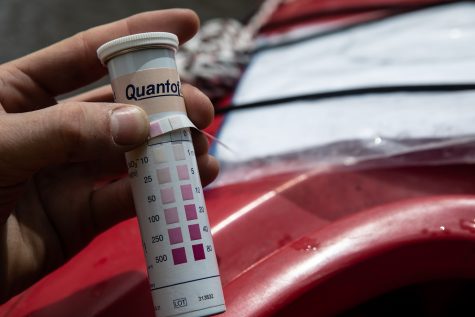
Daily Iowan Photojournalist Ryan Adams holds a test strip * up to a reference to approximate the levels of nitrate north of Iowa Falls, on Friday, May 25. The estimated level of this test was 75 mg/L.
As my journey progressed, testing the river became a familiar routine. The tube containing my test strips came out of its pouch on my life jacket, the lid opened with a thoomp, and out came a small plastic strip with two pads on one end. I leaned over the side of the boat, dipped the pads in the water for a second, and then shook it off as I brought it out of the water.
My right wrist turned upward, allowing me to note the second hand. I had 60 seconds to wait while the chemicals reacted. The strip was marked with the test number, and I took a picture of the strip along with an estimate of the levels.
All data, including the latitude and longitude of each testing location, I entered into a yellow, waterproof journal I had once hoped to purpose as a mountain-climbing logbook.
Sitting in the tent, I began to question myself. I had some whispers of doubt. I knew I had made it halfway through the 329 miles of river I needed to navigate, but all I could think of was real potatoes and a real bed.
I had to remind myself that I needed to keep going through the fatigue I faced, because the curiosity propelled me to continue to discover the river. Up until this point, I had faced physical and mental strain, but never felt the task at hand was more than I could handle. Now, more than 150 miles into the journey, I wrestled with feelings of uncertainty. However, I decided to continue on. I knew I had to complete the expedition regardless of the hardships I faced, because there were uncertainties ahead that still needed to be explored.
***
Every farm and field I saw buried under the river’s flow opened my eyes more and more to the sheer amount of flooding on the river. The river was above normal levels during the entire expedition, and nutrients from surrounding fields made their way into the waterway during that time. For example, a river gauge based at the Coralville Reservoir usually hovers around 685 feet deep; the section had increased to more than 700 feet when I passed through it.
RELATED: 10 years later, the collective memory of the 2008 flood remains
Water depth is only one tool used to measure the conditions in the state’s network of streams. State agencies and researchers are interested in data that indicate the health of the rivers.
Chris Jones, a research engineer with the University of Iowa’s IIHR — Hydroscience and Engineering, monitors 60 real-time sensors in Iowa’s stream network. Current research at IIHR indicates that tiling is increasing in the state.
Tiling is a common farming practice used to drain excess water from fields. A culvert, or drain pipe, system lies in the low point of the field, allowing a path for water to exit. Typically the water enters a nearby waterway.
Tiling soil makes farmland vulnerable to farm runoff and increases the flow of whichever body of water the tiling drains into. Increased streamflow increases erosion in a watershed and creates more rapid flooding.
One IIHR watershed study saw an increase of 12,000 miles of new tiling systems. However, Jones said, the issue remains.
“If we did nothing, would it get a whole lot worse?” Jones said. “I think the answer to that is no. But, I think we do as a society want better water quality, and we do want our drinking water utilities to have robust and clean sources of water.”
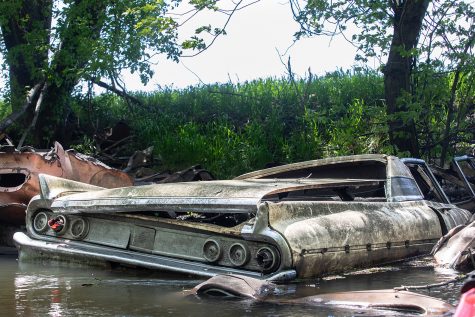
A vintage car protects the riverbank along the Iowa River east of Dows, Iowa, on May 23, 2019. The use of discarded automotive bodies is one of several practices used to reduce bank erosion along the river. This car is one of several lined along the water.
The amount of fertilizer input into fields can affect water quality as well. In many places I passed through, the water was murky with sediment, possibly worse because of erosion from flooding.
Iowa State University publishes a list of recommended fertilizer inputs for fields each year. Because these recommendations are made on a voluntary basis, farmers can choose how much fertilizer they apply to fields each year.
Farmers around Iowa have had to adapt to the increase in annual precipitation, increased length between rainfall, and more intense rainfall, according to a study the U.S. Agriculture Department conducted using data in nine Midwestern states from 2011 to 2015. The report recommended farmers add a diversity of erosion-management tools such as wetlands and cover crops.
One farmer, Dick Sloan of Rowley, Iowa, participated in the USDA and ISU collaborative report and continues to implement nutrient- and erosion-reduction systems. Sloan farms roughly 700 acres in northeast Iowa. Embedded among the field are rows of wetlands, buffer strips, and cover crops.
Sloan’s lips turned up in a half-smile as he walked across his fields. He walked along the rows of corn with a spring in his step, excitedly explaining all the practices he had implemented over the years.
“When I started out, I had corn, hogs, and soybeans, and you feed the corn and soybeans to the pigs, and you use the nutrients from the pig manure … and raise more corn and soybeans, and it struck me as odd,” Sloan said. “That’s a good little system, and it is on small-scale levels, but then there’s a lot missing — the diversity, the potential for adding more diversity.”
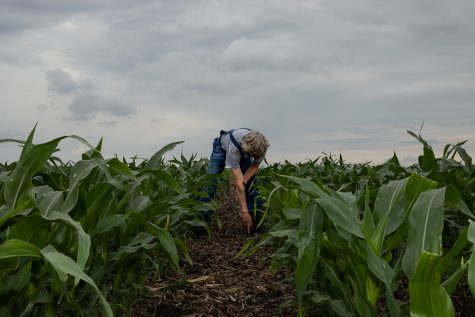
Farmer Dick Sloan points to a section of his cornfield near Rowley on June 18, 2019. Sloan implements cover crops, prairie land, and no till practices to reduce nutrient runoff and soil erosion in his fields.
The same programs that help farmers such as Sloan are funded through state and private sources.
Iowa Gov. Kim Reynolds signed a bill in January 2018 — the first bill she signed upon taking office — that allocated $282 million to water-quality initiatives over the course of 12 years.
Reynolds’ office did not respond to requests for comment from The Daily Iowan.
The Nutrient Reduction Strategy, developed in 2013, acted as a sort of road map for the plan outlined in the bill, aimed at reducing the flow of nitrates into the Gulf of Mexico. The strategy does not legally require farmers to practice farming a certain way; it instead encourages farmers to practice greener farming techniques to prevent farm runoff.
Iowa Sen. Ken Rozenboom, R-Oskaloosa, the chair of the Natural Resources and Environment Committee, said the water-quality bill Reynolds signed was a monumental step in addressing the issue, because there was nothing else like it before.
“I will say that it’s ironic that ever since we passed the bill, the party that did nothing has complained about this being too little,” said Rozenboom, referring to his Democratic opposition. “When they were in control, there was no water-quality bill.”
Sen. Chuck Grassley, R-Iowa, said in a conference call with reporters that former EPA Administrator Gina McCarthy, the head during the Obama administration, made statements during a 2013 visit to Iowa that summarized the effectiveness of the Nutrient Reduction Strategy.
“She was asked at that time if she thought the way that Iowa’s doing it [Nutrient Reduction Strategy] would meet the federal requirements,” Grassley said. “… the fact that she thought that not only would Iowa’s plan satisfy the federal law, but it might be an example for other states to do as well.”
Five years after the launch of the Nutrient Reduction Strategy, a UI study released in 2018 showed that Iowa’s contribution of nitrate pollution in the Gulf of Mexico has spiked by 47 percent in recent years
The study was based on a five-year running of annual totals, but Rozenboom said that because nitrate levels are so sensitive, these studies need to be done during at least a 50-year period to accurately portray the condition of the river.
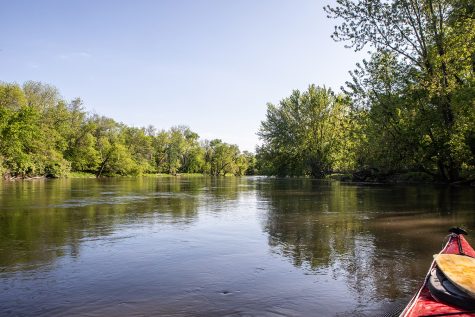
“Common sense should tell people that we don’t do a lot of things that we did two generations ago,” Rozenboom said. “And that has impacted water quality — not for the worse but for the better.”
RELATED: Report finds lack of urgency in addressing Iowa’s water quality
When there’s a spike in nutrients in water, the water’s clarity decreases and sedimentation increases, changing the ecosystem of the waterways. Sediment-tolerable species are more likely to thrive, while clear-water species struggle. Increases of nitrogen and phosphorous also promote algae, which have caused issues in other Midwest communities, especially those along Lake Erie, where bacteria-inducing algae had left communities without drinkable water.
Critics of the bill Reynolds signed say that $282 million is not enough to address the issue of water quality.
Sen. Joe Bolkcom, D-Iowa City, community education director at the Center for Global & Regional Environmental Research, said Republican leaders in the Iowa Statehouse will not raise taxes to invest more money in addressing water quality.
“I think without a change in the General Assembly and the leadership of the General Assembly, we’re going to continue to have kind of a tepid, insufficient effort around soil conservation and water quality,” Bolkcom said.
Because Iowa has endured massive rainfall this year, it’s even more important to address how Iowans can limit the amount of farm runoff.
“… I can see many, many examples of bonehead farming practices and poor farming practices that result in significant erosion and water pollution because of the way the ground is farmed,” Bolkcom said. “If we’re not even able to take care of … basic water quality and soil erosion issues through volunteering means, something more has to give here.”
***
The Iowa River transforms throughout its length. The beginnings are straight and narrow channels running through the farmland of north-central Iowa. From East Twin Lake Wildlife Complex on, the river begins to wind and widen, until it becomes wider than Kinnick Stadium’s football field.
Some of the unique features along the river banks include limestone bluffs in Iowa Falls, the expansive Hawkeye Wildlife Management Area north of Iowa City, and vegetated islands that inhabit the channel after the confluence with the Cedar River.
Jones said it is easy to become pessimistic about the state of water quality in Iowa’s waterways, but there are solutions to the problem, such as diversifying crop rotation.
RELATED: Grad student aims to improve Iowa water quality
Sloan is one of the farmers implementing diversified practices, allowing him to better understand how to efficiently grow crops while reducing nutrient loads. The Rowley farmer said he believes the issue is a matter of opening up others’ minds to implement the practices.
While watching a breeze blow through the infant corn plants in his field, Sloan said, “What we do need is more people trying, and I think that’s the main thing.”
Evidence of flooding followed my boat and me throughout the entire journey. I paddled over a seemingly endless, completely submerged gravel road, I felt the pull of the river as it managed the overflow of water underneath the boat, and I saw the evident force of the water as I passed a crumpled canoe wrapped around a log.
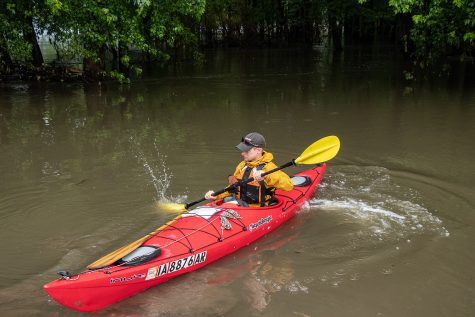
Daily Iowan Photojournalist Ryan Adams paddles along the bank of the Iowa River north of Oakville, Iowa near the confluence with the Mississippi River on June 25, 2019. The final day of the expedition covered 5.5 miles, ending the 329-mile trip which started May 20, 2019.
I went to the river for answers, and while I did learn from the people I spoke with, the flooding I experienced, and the tests I conducted, the resounding answer I found came from the river itself: Water quality isn’t a simple issue to approach. It’s like the river — ever-changing course, rising and lowering. Like the river, the issue is complex.
The nutrient levels may be high, and flooding may increasingly affect Iowa, but if anyone can come together and create change, it’s the people of this state.
It’s the farmer in the field, enthusiastically explaining new conservation practices, the angler describing a lifelong relationship to a particular fishing hole along the river, the friends enjoying a weekend getaway as they paddle down the river that gives me hope.
